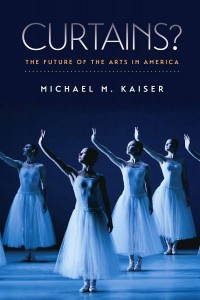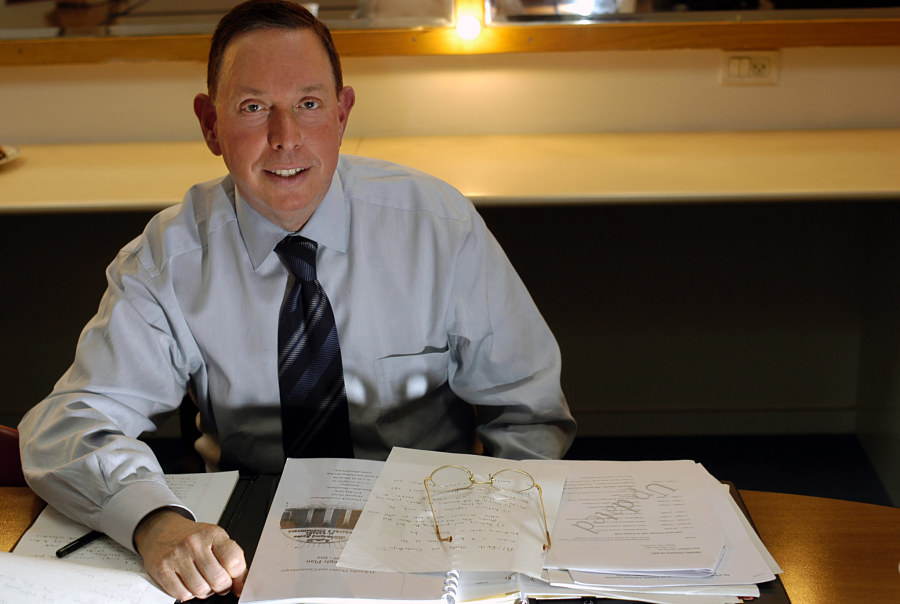There may be no one better suited to predicting the future of the arts in America than Michael Kaiser. Not only does he boast an extraordinary track record as the field’s foremost turnaround artist; with the exception of his 13-year tenure at Kennedy Center, he has worked his magic in absurdly short bursts of time at institutions that present every major performing art form. So when Michael Kaiser speaks or writes, attention should be paid.

Curtains? is his forecast for a climate change every bit as alarming, in its own right, as Mother Earth’s. In this monograph-long book, whose title announces the gravity of his project, Kaiser conjures a Darwinian future of haves and have-nots, winners—and mostly losers. For Kaiser, today’s storm clouds are the harbinger of a sharply divided cosmos and a great industry reset.
Because his experience has been primarily with classical repertory—mostly titles that resonate immediately with an educated core audience—theatremakers whose focus is on new work may feel they have a different set of challenges than the ones he lays out. And to be sure, Kaiser’s resume includes a relatively smaller percentage of theatre projects compared to his experience with ballet and opera. Still, his forthright common sense is relevant to companies of any art form and size.
The author of three books on arts management and a premier arts consultant, Kaiser has always preferred a meat-and-potatoes managerial method; his mantra is “good art, well marketed.” For those not inclined to buy the elixir of institutional innovation currently peddled by some consulting firms, Kaiser’s approach is refreshingly straightforward. And in an important way he might be considered a contrarian: Instead of obsessing over fiscal responsibility, he is a cheerleader for artistic ambition.
“Whenever the budget is developed before the art is conceived, one is likely to produce staid, less interesting work,” he writes, in a statement likely to make many boards of directors very nervous. Yet Kaiser’s explanation of why artistic enterprises continually face fiscal headwinds should make sense to even the most hard-nosed businessperson. The arts have a difficult time increasing worker productivity because of the personnel needed for large-scale productions and complete seasons. This results in a higher rate of inflation than that experienced by companies involved in banking, steel or automobile manufacturing. Diminishing the scale of artistic production is anathema to Kaiser, who argues that smaller seasons will struggle to attract contributed income.
Kaiser sets the stage for his forecast by reviewing the explosion in the accessibility and diversity of live performances and visual arts exhibitions in the second half of the 20th century. But even before this summary of the Golden Age, he describes the clouds that darken current conditions: “Only a few arts organizations are managed well…Too many of them do little or no real planning…fail to produce interesting art, do not know how to market or raise funds, are governed by weak or ineffective boards, have failed to exploit new technologies wisely…are clumsy about embracing supporters, both old and new…and are limping from one season to the next.”
One of the causes of this lassitude, he writes, is a uniformity of artistic product. “Rather than conceiving great projects—with enough lead time to find the resources needed to pay for them—too many organizations are planning art that is inexpensive, undemanding and, frankly, boring.” If companies programmed more creatively “there wouldn’t be 20 ballet companies performing Giselle and 50 theatre companies doing Driving Miss Daisy in one week.”
He shares a canny insight derived from business theory: When products begin to look alike, the price sensitivity of buyers increases, and economies of scale play a larger role. Companies that have raised ticket prices too steeply earn his special disapproval, as he feels they’ve violated their missions by discouraging the audiences for which they exist. Writes Kaiser, “The arts are not unpopular—they have simply grown too expensive.”
The current precarious state of so many institutions is a result of a confluence of factors in the new millennium. But none is more critical for Kaiser than a generation of college students who, he feels, did not receive consistent arts education in elementary and high school. These unfortunate souls are, “by and large, illiterate with respect to classical repertory.” One might add that, unlike their parents, they were never trained in the habit of arts attendance. Kaiser sees the focus on STEM education, to the detriment of the liberal arts, as another cause of the decline in arts attendance. He anticipates these conditions will ultimately have a major impact on future giving, as those not conversant with the arts seek other avenues for their philanthropy.
Another blow to the arts has been the decline in government funding. During the Great Recession alone local government support for the arts fell 18 percent, while state funding dropped 27 percent. Between 1992 and 2012, adjusted for inflation, total government support declined 31 percent.
If Kaiser’s view of current arts affairs isn’t stomach-churning enough, an arts manager can only be thankful we have two more decades to prepare for the brave new world he prophesies by 2035. Among his predictions: Today’s array of nonprofit theatres will shrink significantly, with a disproportionately negative effect on diverse companies; the cost and accessibility of online events will reduce the number of live performances, as tickets at major companies will top the $1,000 level; accordingly, most who choose to experience theatre will do so in the confines of their home, via online streaming; a second generation of children with scant arts education will significantly reduce demand for the classical repertory; smaller organizations will struggle mightily to get the attention of what remains of arts journalism; the work force will be working harder, spending more time at computers, with less predictable time off; that more theatres will feel “house poor,” as the occupancy rate of many arts centers will experience a precipitous decline. “Many will sit vacant, reminders of a different era, not unlike the Colosseum in Rome and the Parthenon in Athens,” Kaiser writes.
It would be easy to dismiss such a gloomy outlook if it weren’t rooted in long-standing trends and recent technology. While the American theatre has been surprisingly slow to participate in broadcasting, Kaiser believes it “represents the single most important change in the way arts have been distributed since the mid-20th century” and a fundamental influence on the future of American arts. The numbers already bear him out: More people watch an HD-broadcasted production of the Royal Shakespeare Company in one night than go to Stratford in a year. For better or worse, he predicts, broadcasting will provide unprecedented access and international acclaim for the Kennedy and Lincoln Centers of the world, resulting in a demand for larger-scale productions, not to mention an expansion of the divide between large and small organizations. Not even the Internet may rescue the little guys; organizations with greater name recognition and more programming are likely to attract much more online activity.
One of the key takeaways from Curtains? is that if mid-sized organizations don’t either merge or successfully attract younger audiences on their own, many will disappear. Partnerships and joint ventures are methods Kaiser endorses. Will the current strategy of coproductions morph into companies that reside periodically in two or more locations? Kaiser bluntly declares that most mid-sized institutions are “simply not interesting enough to continue to earn support.” While they may not garner national recognition, some of these companies are important local purveyors. But will tomorrow’s audiences continue to buy local?
Curtains? presents a mixed projection for smaller organizations: Many will be community-focused, offer low wages and have trouble attracting attention, Kaiser writes. This arena, though, may also be the place for young, enterprising talent to gain a foothold. Smaller, more nimble ventures, “far more flexible than the behemoth organizations,” will develop. Though he doesn’t mention them in this book, highly successful models along these lines have already appeared—companies of like-minded artists unburdened by the costs of operating a facility. From Fiasco Theater in New York to National Theatre of Scotland, this model is likely to expand, and may even help fill those half-empty colosseums.
Regardless of the enormity of future challenges, Kaiser insists that “one simply cannot save one’s way to health in the arts.” Survival in the universe he foresees will depend on creating exciting, ambitious work that distinguishes itself from online competition. Organizations will be able to overcome the lack of arts education, but only if they produce “astonishing, relevant, and remarkable” work. It’s reasonable to assume that companies with the resources to commission and develop unique, large-scale projects will clearly hold the advantage in sustaining such a high bar.
For theatres of all sizes, though, technology will be a critical ingredient for survival. As in museums, where attendees already “curate” their visits, “people will conduct virtual orchestras, act in movies, design theatre sets and costumes. They will be able to record the results and share them online.” So far theatre has yet to harness existing technology to engage young audiences and create a fan base as rabid as fantasy sports addicts. Kaiser believes organizations must mimic the “family-building skills” practiced by sports franchises, investing in what he calls “institutional marketing.”
Still, Kaiser says, the best marketing strategy is a “transformational project” brilliantly produced. For someone who came to the arts through business and who admits that he learned much of what he knows on the job (at Kansas City Ballet), this is a remarkable perspective. “If every arts organization would improve the quality, the excitement, and the dreaminess of their work,” he writes, “the future of the arts would look very different.” Amen to that.
Michael Bloom is a former artistic director of Cleveland Play House and a freelance director and writer in the D.C. area.


